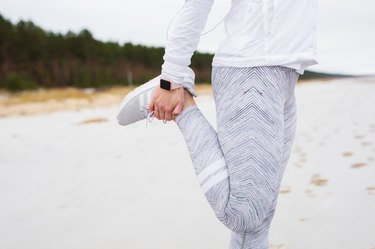
Stretching is supposed to protect you from injury, right? Well, not always — especially if you don't take precautions. If you've recently had a painful flexibility-training session, pushing too hard while you're still sore from stretching can actually make things worse.
Video of the Day
Video of the Day
Tip
Slightly tight muscles may loosen after additional, gentle stretching. Often, however, "working through the pain" will only make strained muscles worse.
Understand the Dangers of Stretching
Stretching cold muscles can pull or strain them. Under normal circumstances, these strains abate after a day or two of rest. But if you don't wait long enough after painful flexibility training, extending your body into various poses can re-strain the muscles. In effect, you risk increasing, rather than easing, the pain through stretching.
If you find that you're consistently sore after stretching, even when your muscles are warmed up, you may need help with your technique. Don't be afraid to contact a trainer for stretching advice or a medical professional to evaluate whether you have a serious injury.
Stretching during a muscle cramp can also do some serious damage. When muscles go into spasm, the fibers in muscle tissue become tense and shortened. Attempting to stretch when these tissues are at their least elastic can seriously injure muscle fibers.
Feel the Pull — Not the Burn
It's not always easy to know if you're too sore from stretching (or from some other kind of muscle strain or joint pain) to risk flexibility work. That's why there's nothing wrong with trying to stretch. Your body will let you know within moments whether the kind of stretching you're doing is a good idea.
Go into your stretch cautiously. If you feel pain from stretching right away, discontinue your flexibility session. Otherwise, reach into the stretch as far as you can before it stops feeling like a slightly uncomfortable pull on your muscles. If it feels painful, ease back slightly until it's only mildly uncomfortable. Hold yourself in that position for about 15 to 30 seconds; then slowly go back to your original position. Repeat a few times, unless you start to cramp or feel pain.
Avoid Stretching Mistakes
Along with making sure not to push to the point of pain when you're stretching muscles, there are some other stretching guidelines to keep in mind. Following them may help you lessen your current pain, as well as to avoid future overstrain.
Perhaps the biggest myth that still persists with less-experienced athletes is that stretching should precede any vigorous activity. In reality, the best way to warm up cold muscles is to start off with a less-intense version of your activity such as walking prior to running. If you stretch cold muscles, you risk pulling or straining them.
Other potential dangers of stretching involve "bouncing" movements. This type of flexibility work, known as ballistic stretching, has its share of advocates in the pro athlete world. But for most people, it's far better to ease into your stretch; then gently release. Another common mistake is to consistently favor one side of your body. That can leave your other muscles and joints more vulnerable to injury.
Use Stretching Preventively
If you're feeling only mildly sore after recent painful flexibility training, careful stretching may actually ease discomfort. Static stretching corrects the tightness that comes from improper posture while sitting. It also increases range of motion, making it less likely that you'll be injured during a future workout session or active day outside.
To do static stretching properly, warm up the muscles you'll be stretching first. Next, reach into your first stretch position. Hold the stretch pose for about 15 to 30 seconds. Rest briefly; then repeat the same stretch two or three times before moving on to another flexibility move.
- American Council on Exercise: Why Do Muscles Tighten Up?
- Mayo Clinic: Stretching: Focus on Flexibility
- Columbia University: Is It Okay to Stretch When I Am Still Sore?
- Healthline: Can Ballistic Stretching Be Dangerous?
- Jillian Michaels: Why Do Muscles Get Sore After Stretching?
- Prescription to Get Active: Mindful Stretching
Is this an emergency? If you are experiencing serious medical symptoms, please see the National Library of Medicine’s list of signs you need emergency medical attention or call 911.